Table of Contents
ToggleThe Anatomy of a Cyber Attack: Understanding the Threat to Your Business
Cybersecurity has become a critical issue for businesses worldwide, and Canadian small and mid-sized enterprises (SMEs) are no exception. In fact according to Canadian Internet Registration Authority (CIRA) 2023 Report, 28% of Canadian businesses experienced a cyber attack in 2023, with SMEs being particularly vulnerable. Based on a recent report published by IBM, average cost of a data breach in Canada has risen to $6.35 million, highlighting the severe financial risks involved. Understanding how these attacks unfold can help businesses protect themselves better.Why Canadian SMEs Are at Risk
Small and mid-size businesses (SMEs) in Canada are especially targeted due to limited cybersecurity budgets and resources. Many small businesses still rely on outdated systems, making them easy targets for cybercriminals. According to CIRA, 38% of SMEs do not have a formal cybersecurity plan in place, making them particularly susceptible to attacks.Why did we write this article?
The purpose of this article is to shed light on the growing cybersecurity threats facing Canadian SMEs to introduce these attacks and provide practical, actionable advice on how to protect and prevent these attacks.The structure of this article
We first introduce a couple of common cyber attack frameworks and the common types of cyber attacks, aiming to educate SMEs on the methods cybercriminals use and the vulnerabilities they exploit.Furthermore, the article offers a comprehensive guide on how to bolster cybersecurity defenses, ensuring that even with limited resources, SMEs can significantly reduce their risk of falling victim to cyber-attacks.Ultimately, this article is designed to empower Canadian SMEs with the important knowledge and tools they need to safeguard their operations, protect their data, and ensure business continuity in an increasingly digital world.The Stages of a Cyber Attack
Cyber Kill Chain Framework
To fully understand a cyber attack, it’s essential to recognize the typical stages that attackers follow, based on the Cyber Kill Chain framework developed by Lockheed Martin. In this framework the cyberattack goes thought the life cycle below:
In this framework the cyberattack goes thought the life cycle below:- Reconnaissance: The attacker gathers information about the target, identifying potential vulnerabilities. This can involve scanning for open ports, researching employees via social media, or even spear-phishing specific individuals within the organization.
- Weaponization: After identifying weaknesses, the attacker creates a weapon, such as malware or a phishing email, designed to exploit the identified vulnerabilities.
- Delivery: The weapon is delivered to the target via email, a compromised website, or another vector, such as a USB drive.
- Exploitation: Once delivered, the weapon is executed, exploiting the vulnerability in the target system. This could involve exploiting a software flaw, a misconfigured network, or human error.
- Installation: The attacker installs malicious software (malware) on the target system, establishing a foothold in the network.
- Command and Control (C2): The attacker establishes a command-and-control (C2) channel, allowing them to communicate with and control the compromised system remotely.
- Actions on Objectives: The attacker carries out their primary goal, whether it’s data theft, network disruption, or deploying ransomware.
MITRE ATT&CK Framework
The MITRE ATT&CK Framework (Adversarial Tactics, Techniques, and Common Knowledge) is another comprehensive, globally accessible knowledge base of adversary tactics and techniques based on real-world observations. Unlike the linear Cyber Kill Chain, the MITRE ATT&CK Framework is structured as a matrix, providing a more detailed and flexible approach to understanding how cyber attacks unfold. Typically steps are as follows:
Typically steps are as follows:- Initial Access: Initial Access refers to the techniques that adversaries use to gain an initial foothold within a network. This is the first step in the attack, where attackers breach the target environment.
- Execution: Execution involves techniques that adversaries use to run malicious code on a compromised system. Once initial access is gained, attackers need to execute code to achieve their objectives.
- Persistence: Persistence techniques allow adversaries to maintain their foothold in the network despite disruptions such as system reboots or credential changes. This step ensures that the attacker can regain access to the system after a breach.
- Privilege Escalation: Privilege Escalation involves techniques that adversaries use to gain higher-level permissions on a system. By escalating privileges, attackers can perform actions that require administrator or root-level access, expanding their control over the environment.
- Defense Evasion: Defense Evasion refers to the techniques adversaries use to avoid detection and maintain their presence on the compromised system. This step is crucial for the attacker to operate stealthily within the network.
- Credential Access: Credential Access involves techniques that adversaries use to steal account credentials, such as usernames and passwords. Obtaining credentials allows attackers to move laterally within the network and escalate privileges.
- Discovery: Discovery techniques are used by adversaries to gather information about the network and the devices within it. This step helps attackers understand the environment and identify potential targets for further exploitation.
- Lateral Movement: Lateral Movement involves techniques that adversaries use to move through the network from one system to another. This allows attackers to spread their reach and compromise additional systems within the environment.
- Collection: Collection refers to techniques that adversaries use to gather data of interest from compromised systems. This data might include sensitive documents, credentials, or other valuable information.
- Command and Control (C2): Command and Control (C2) techniques involve establishing communication channels between the compromised system and the adversary. This allows attackers to send commands to the compromised systems and receive data from them.
- Exfiltration: Exfiltration involves techniques that adversaries use to steal data from the compromised environment and transfer it to a location they control. This step is often the ultimate goal of the attack.
- Impact: Impact techniques are used by adversaries to disrupt operations, destroy data, or otherwise harm the target environment. These actions are often the final stage of an attack.
Common Types of Cyber Attacks
1. Phishing Attacks
According to a recent report published by Verizon, Phishing is the most prevalent type of cyber attack, responsible for 91% of all data breaches. In a phishing attack, the attacker impersonates a legitimate entity to deceive individuals into revealing sensitive information, such as login credentials or credit card numbers.What happens in Phishing Attacks:- The attacker sends a fraudulent email that closely resembles a legitimate one from a trusted source, such as a bank or a colleague.
- The email contains a link to a fake website designed to capture credentials or an attachment that executes a script to install malware upon opening.
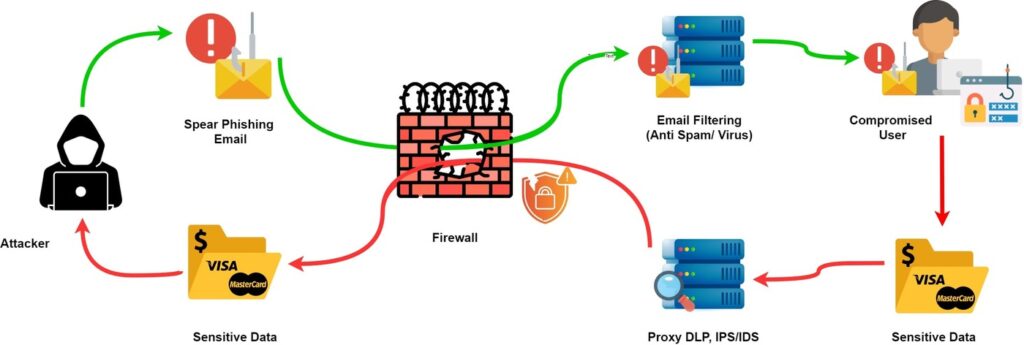 How do these attacks work:
How do these attacks work:- Spoofing Techniques: Attackers use spoofing to disguise the email sender’s address, making it look like it comes from a trusted domain. This often bypasses email filters.
- Social Engineering: The email content is crafted to exploit human psychology, such as creating a sense of urgency (“Your account will be locked if you don’t respond immediately”).
- Payload Delivery: The payload could be anything from a keylogger to ransomware, depending on the attacker’s objectives. If a link is clicked, it may lead to a website mimicking a legitimate one, where credentials are harvested.
2. Ransomware Attacks
Ransomware is a type of malware that encrypts the victim’s data, demanding payment for the decryption key. According to a recent report by the Canadian Centre for Cyber Security, Ransomware attacks have surged in Canada, with over 60% of Canadian businesses reporting a ransomware incident in 2023.How It Happens:- The attacker delivers ransomware through phishing emails, malicious websites, or by exploiting vulnerabilities in outdated software.
- Once the malware is installed, it encrypts files on the victim’s system, rendering them inaccessible.
- A ransom note is then displayed, demanding payment (often in cryptocurrency) for the decryption key.
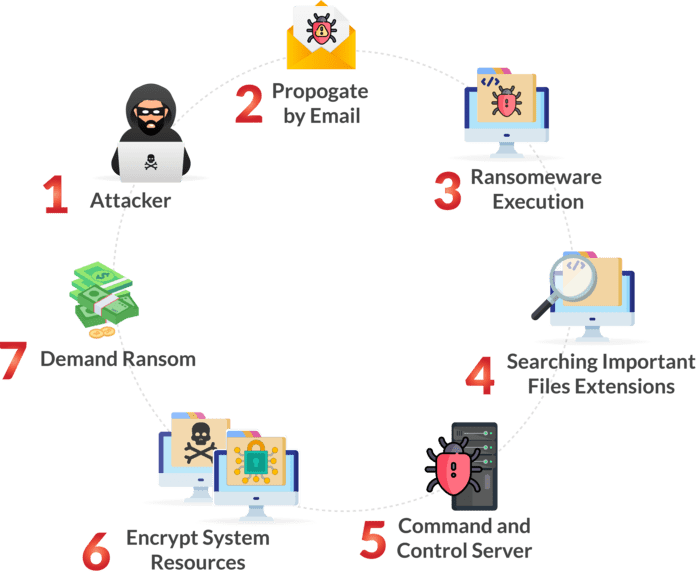 How do these attacks work
How do these attacks work- Encryption Methods: Modern ransomware uses advanced encryption algorithms like AES-256, making decryption nearly impossible without the key.
- Lateral Movement: Once inside, the ransomware often spreads laterally across the network, encrypting files on multiple devices.
- C2 Communication: The ransomware communicates with a command-and-control server to generate the encryption key and send the ransom demand, often using Tor to hide the attacker’s identity.
3. Distributed Denial of Service (DDoS) Attacks
DDoS attacks involve overwhelming a server or network with a flood of traffic, causing it to crash or become unavailable. These attacks have increased in frequency. Based on a recent study done by Akamai, Canada is among the top 10 countries targeted by DDoS attacks in 2023.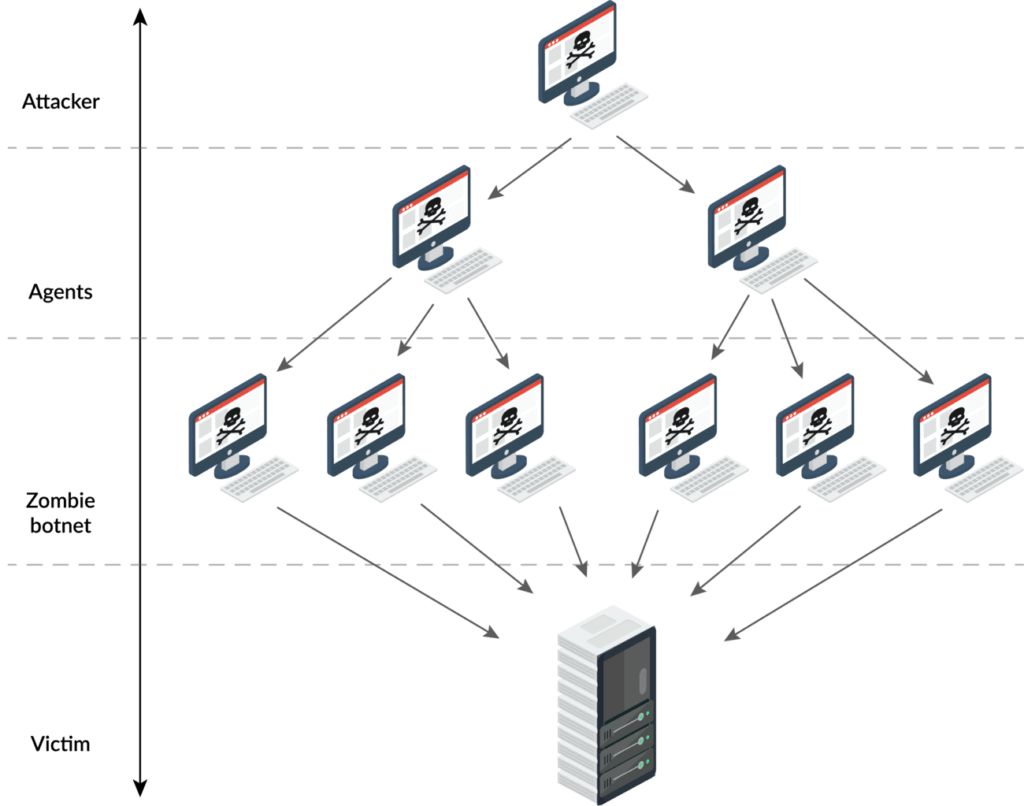 How It Happens:
How It Happens:- The attacker uses a botnet—a network of compromised devices—to send an overwhelming amount of traffic to the target server.
- The server becomes overloaded and unable to respond to legitimate traffic, leading to service disruption.
- Botnets: DDoS attacks are typically executed using botnets, which are networks of infected devices controlled remotely by the attacker.
- Traffic Amplification: Techniques like UDP amplification can multiply the attack’s impact by sending small queries that generate large responses, overwhelming the target.
- Mitigation Challenges: Defending against DDoS attacks requires filtering malicious traffic while ensuring legitimate traffic is not blocked, often requiring advanced firewall and load-balancing techniques.
4. Insider Threats
Insider threats involve individuals within the organization—employees, contractors, or business partners—who misuse their access to the company’s systems for malicious purposes. These threats are particularly dangerous due to the level of access insiders have. How It Happens:
How It Happens:- A malicious insider deliberately leaks sensitive data or sabotages systems.
- An accidental insider inadvertently causes harm by falling victim to a phishing attack or misconfiguring a system.
- Privileged Access Misuse: Insiders with privileged access can cause significant damage by leaking data or compromising systems.
- Data Exfiltration Methods: Insiders may use USB drives, cloud storage, or email to exfiltrate sensitive data, making it hard to detect.
- Detection and Prevention: Detecting insider threats often involves monitoring user behavior and implementing strict access controls, which can be challenging without infringing on privacy.
5. Man-in-the-Middle (MitM) Attacks
Man-in-the-Middle (MitM) attacks occur when an attacker secretly intercepts and potentially alters the communication between two parties without their knowledge. This type of attack is particularly dangerous because it can be difficult to detect, and it allows the attacker to eavesdrop on or manipulate the information being exchanged.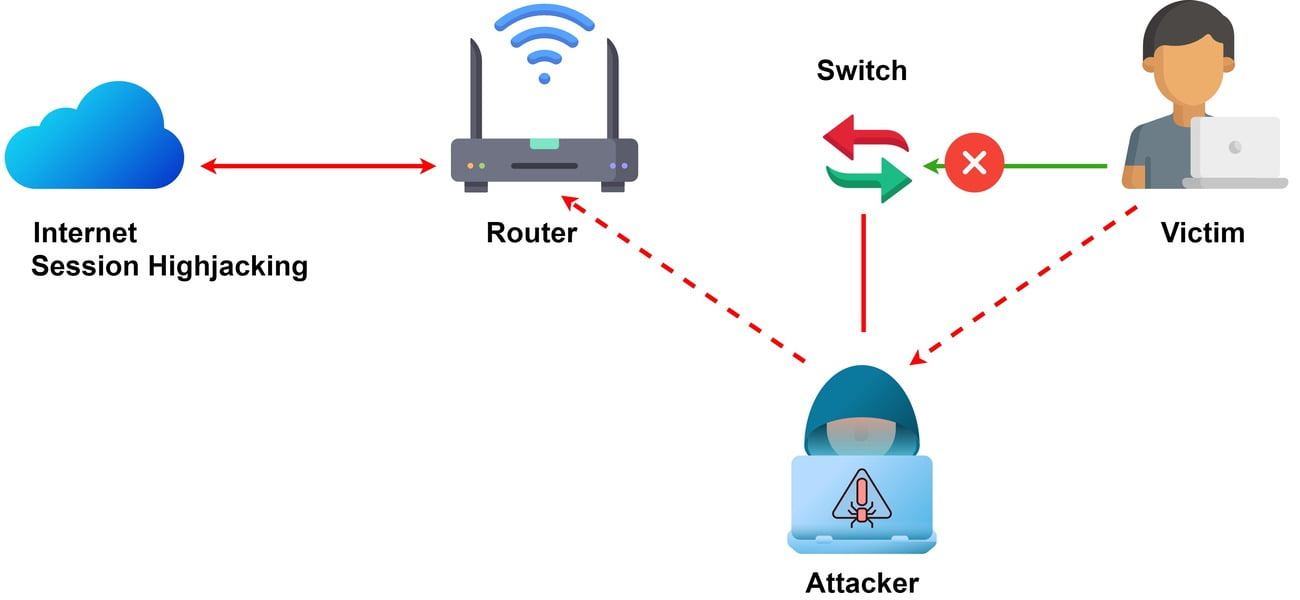 How It Happens:
How It Happens:- The attacker positions themselves between the victim and the entity they are communicating with, such as a website or another person.
- This is often achieved through techniques like IP spoofing, DNS spoofing, or by compromising a Wi-Fi network.
- Once in place, the attacker can intercept, decrypt, or even alter the data being transmitted, such as login credentials, financial information, or sensitive communications.
- Wi-Fi Eavesdropping: One common form of MitM involves setting up a rogue Wi-Fi network that appears legitimate. When users connect to it, the attacker can intercept all data passing through the network.
- SSL Stripping: Attackers can downgrade a secure HTTPS connection to an unencrypted HTTP connection, making it easier to intercept and read data.
- Session Hijacking: In some cases, attackers can take over a user’s session after they’ve authenticated with a website, gaining access to their account.
6. SQL Injection Attacks
SQL Injection is one of the most common and dangerous types of web application attacks. It involves inserting or “injecting” malicious SQL code into a web application’s input fields to manipulate the backend database and retrieve sensitive information.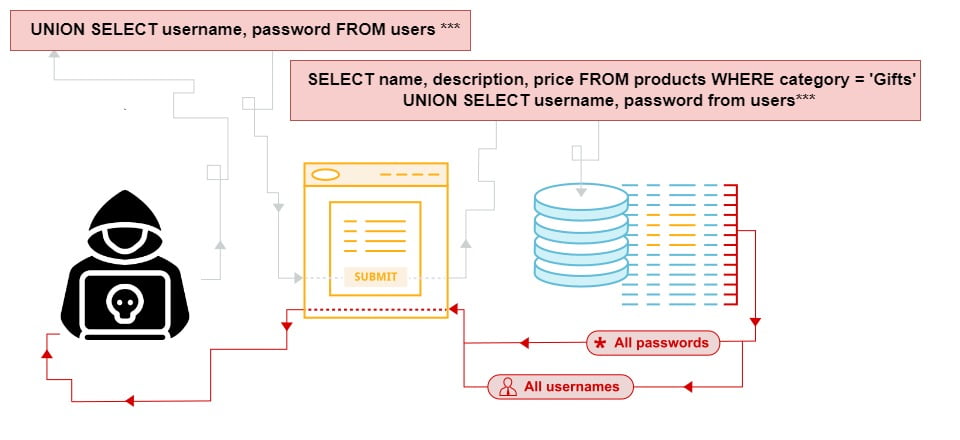 How It Happens:
How It Happens:- An attacker identifies a vulnerable input field in a web application, such as a login form or search box.
- They then inject malicious SQL code into the input field, which the application mistakenly executes as part of a legitimate query to the database.
- This can allow the attacker to bypass authentication mechanisms, access, modify, or delete data, and in some cases, take full control of the database.
- Error-Based SQL Injection: This technique relies on the web application generating error messages that reveal information about the database structure. Attackers use these errors to craft more effective queries.
- Union-Based SQL Injection: Attackers use the UNION operator to combine the results of the injected query with those of a legitimate query, allowing them to retrieve data from other tables in the database.
- Blind SQL Injection: When the web application does not return error messages, attackers use blind SQL injection techniques, relying on true or false conditions to infer information from the database.
How to Protect Your Business and Prevent Cyber Attacks: Protecting Your Business
The good news is that with the right strategies and tools, you can significantly reduce your vulnerability to cyber threats. Moving forward we will outline practical steps to protect from and prevent cyber attacks, ensuring your business remains secure and resilient.1. Implement a Robust Cybersecurity Framework
The foundation of any successful defense against cyber attacks is a comprehensive cybersecurity framework. This framework should be tailored to the specific needs of your business, considering factors like the size of your organization, the nature of your data, and the risks you face.- Security Policies and Procedures: Begin by establishing clear security policies and procedures. These should cover everything from acceptable use of company devices to protocols for handling sensitive information. Regularly review and update these policies to adapt to new threats.
- Access Control Measures: Implement strict access controls to ensure that only authorized personnel have access to sensitive data. This can be achieved through role-based access control (RBAC), which limits access based on an employee’s role within the company.
- Multi-Factor Authentication (MFA): MFA adds an additional layer of security by requiring users to verify their identity through multiple methods, such as a password and a one-time code sent to their mobile device. This significantly reduces the risk of unauthorized access.
2. Regularly Update and Patch Software
One of the most common entry points for cyber attacks is outdated software with known vulnerabilities. Regularly updating and patching your software can help close these gaps, preventing attackers from exploiting them.- Automated Patch Management: Implement an automated patch management system to ensure that all software, including operating systems and applications, is up to date. This minimizes the risk of vulnerabilities being overlooked.
- Vulnerability Scanning: Regularly conduct vulnerability scans to identify potential weaknesses in your systems. These scans should be part of a broader vulnerability management program that prioritizes and addresses risks based on their severity.
3. Employee Training and Awareness
Human error is a leading cause of cyber incidents, making employee training and awareness crucial to your cybersecurity strategy. Educating your staff on how to recognize and respond to potential threats can dramatically reduce your risk.- Phishing Awareness: Conduct regular training sessions that focus on identifying phishing emails and other social engineering tactics. Employees should know the signs of a phishing attempt and understand the importance of reporting suspicious activity.
- Security Best Practices: Teach employees about the importance of strong passwords, avoiding public Wi-Fi for work-related activities, and securing their devices. Make security a part of your company culture by encouraging ongoing education and vigilance.
- Simulated Attacks: Periodically run simulated phishing attacks to test your employees’ awareness and readiness. Use the results to refine your training programs and address any gaps in knowledge.
4. Deploy Advanced Threat Detection and Response Tools
To effectively combat cyber threats, businesses must deploy advanced tools designed to detect and respond to suspicious activity in real time.- Intrusion Detection and Prevention Systems (IDPS): IDPS monitors network traffic for malicious activity and can automatically block or alert administrators to potential threats. This proactive approach helps stop attacks before they can cause significant damage.
- Endpoint Detection and Response (EDR): EDR tools provide visibility into endpoint activities, enabling rapid detection of malicious behavior. These tools can isolate infected devices to prevent the spread of malware across the network.
- Security Information and Event Management (SIEM): SIEM systems collect and analyze data from various sources to detect unusual patterns that may indicate a security incident. By correlating data from across the network, SIEMs provide a comprehensive view of your security posture.
5. Develop and Test a Comprehensive Incident Response Plan
Even with the best defenses in place, it’s essential to have a plan for responding to cyber incidents. A well-prepared incident response plan (IRP) ensures that your team can quickly and effectively contain and mitigate an attack, minimizing damage to your business.- Incident Response Team: Establish a dedicated incident response team (IRT) with clearly defined roles and responsibilities. This team should include representatives from IT, legal, communications, and executive leadership.
- Response Procedures: Outline the specific steps to take in the event of a cyber attack, including how to contain the breach, eliminate the threat, and recover from the incident. Ensure that your procedures comply with regulatory requirements, such as breach notification laws.
- Regular Testing: Regularly test your incident response plan through tabletop exercises and simulated attacks. This helps ensure that your team is prepared and can respond effectively under pressure.
6. Backup and Disaster Recovery Planning: The Comprehensive Strategy That Brings Everything Together
While each of the previous steps is vital to a strong cybersecurity posture, it’s the Backup and Disaster Recovery Planning (BCDR) that truly brings everything together. A robust BCDR plan not only ensures your business can recover quickly from a cyber attack but also integrates all other security measures into a cohesive strategy. Every company should consider a BCDR plan as an essential component of their overall cybersecurity framework.- Data Backup Strategy: Implement a data backup strategy that includes regular, automated backups of all critical data. Store backups in a secure, offsite location and ensure they are protected from potential attacks, such as ransomware.
- Disaster Recovery Plan (DRP): Develop a comprehensive DRP that outlines how to restore IT systems and data in the event of a cyber attack. This plan should include recovery time objectives (RTOs) and recovery point objectives (RPOs) to minimize disruption.
- Regular Testing: Regularly test your backups and DRP to ensure they function as expected. This includes verifying the integrity of backup data and conducting full-scale recovery tests.
- Integration with Other Security Measures: A strong BCDR plan should incorporate your incident response plan, threat detection tools, and employee training programs. This ensures that all elements of your cybersecurity strategy work together seamlessly, enabling a quick and efficient recovery from any attack.
7. Specific Measures to Protect Against Man-in-the-Middle (MitM) Attacks
MitM attacks pose a significant threat to businesses that have many remote employees, especially if users connect to unsecured or compromised networks. Implementing strong encryption and secure communication protocols can help protect against these types of attacks.- Use of HTTPS Everywhere: this is already done in most SaaS applications you buy subscriptions for and use for your business, however, we still come across legacy and internally built applications that do not implement HTTPS. Ensure that all web communications are conducted over HTTPS rather than HTTP. This encrypts data in transit, making it significantly harder for attackers to intercept or tamper with the information.
- Implement VPNs for Remote Workers: A Virtual Private Network (VPN) encrypts all data transmitted between the user’s device and the company’s network. This is critically important for remote workers who may connect from public Wi-Fi networks, which are prime targets for MitM attacks.
- Certificate Pinning: Implement certificate pinning in your applications. This security measure ensures that your application only accepts the correct public key from a trusted server, mitigating the risk of SSL stripping attacks.
- Regularly Update Your Web Browsers and VPN: Keeping software up to date is crucial in defending against vulnerabilities that could be exploited in MitM attacks. This includes regularly updating web browsers, operating systems, and VPN clients.
8. Specific Measures to Protect Against SQL Injection Attacks
SQL Injection even though common, requires more advanced knowledge of the web so we won’t dive deeper into it in this article. Know that these attacks are devastating and target web applications. If your business has developed custom applications for its operation, it is important to review how these applications interact with databases, so you can prevent attackers from executing malicious SQL code.- Web Application Firewalls (WAFs): Deploy a WAF to monitor and filter incoming web traffic, blocking SQL injection attempts before they reach the application. WAFs can be particularly effective in identifying and preventing common attack patterns.
- Use of Parameterized Queries: Ensure that all database queries are parameterized or use prepared statements. This approach separates SQL code from data input, preventing malicious SQL from being executed.
- Input Validation and Sanitization: Implement strong input validation and sanitization processes to ensure that any user-provided data is properly cleaned and filtered before being processed by the database. This is a fundamental step in preventing SQL injection.
Engage in Regular Security Assessments and Audits
Regular security assessments and audits are essential for identifying potential weaknesses in your cybersecurity posture and ensuring compliance with industry standards.- Penetration Testing: Conduct penetration tests to simulate real-world attacks on your systems. These tests can reveal vulnerabilities that might otherwise go unnoticed and provide actionable insights for improving security.
- Compliance Audits: Ensure that your cybersecurity practices meet industry-specific regulatory requirements, such as GDPR, HIPAA, or PCI-DSS. Regular audits help you identify and address compliance gaps.
- Continuous Improvement: Use the findings from assessments and audits to continuously improve your cybersecurity strategy. Regularly review and update your security measures to stay ahead of emerging threats.